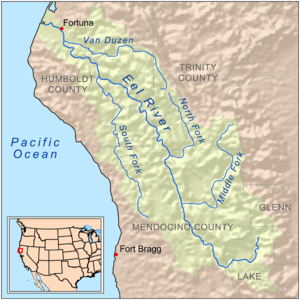
Wailaki
Encyclopedia

Native Americans in the United States
Native Americans in the United States are the indigenous peoples in North America within the boundaries of the present-day continental United States, parts of Alaska, and the island state of Hawaii. They are composed of numerous, distinct tribes, states, and ethnic groups, many of which survive as...
that traditionally live on or near the Eel River
Eel River (California)
The Eel River is a major river system of the northern Pacific coast of the U.S. state of California. Approximately 200 miles long, it drains a rugged area in the California Coast Ranges between the Sacramento Valley and the ocean. For most of its course, the river flows northwest, parallel to the...
of northwestern California
California
California is a state located on the West Coast of the United States. It is by far the most populous U.S. state, and the third-largest by land area...
.
These groups speak dialects of a single language belonging to the Athapaskan language family which is prominently represented in Alaska
Alaska
Alaska is the largest state in the United States by area. It is situated in the northwest extremity of the North American continent, with Canada to the east, the Arctic Ocean to the north, and the Pacific Ocean to the west and south, with Russia further west across the Bering Strait...
, western Canada
Western Canada
Western Canada, also referred to as the Western provinces and commonly as the West, is a region of Canada that includes the four provinces west of the province of Ontario.- Provinces :...
, and the southwestern U.S. Other related Athapaskan groups neighboring the Eel River Athapaskans included the Hupa
Hupa
Hupa, also spelled Hoopa, are a Native American tribe in northwestern California. Their autonym is Natinixwe, also spelled Natinookwa, meaning "People of the Place Where the Trails Return." The majority of the tribe is enrolled in the federally recognized Hoopa Valley Tribe; however, some Hupa are...
-Whilkut
Whilkut
The Whilkut were an Athapaskan tribe, speaking a dialect similar to the Hupa and Chilula, who inhabited the area on or near the upper Redwood Creek and along the Mad River except near its mouth, up to Iaqua Butte, and some settlement in Grouse Creek in the Trinity River drainage in Northwestern...
-Chilula
Chilula
The Chilula were an Athapaskan tribe who inhabited the area on or near lower Redwood Creek, in Northern California, some 500 to 600 years before contact with Europeans...
to the north, the Mattole on the coast to the west, and the Kato
Kato (tribe)
The Cahto are a indigenous Californian group of Native Americans in the United States. Today they are enrolled as the federally recognized tribe, the Cahto Indian Tribe of the Laytonville Rancheria or a small group of Cahto are enrolled in the Round Valley Indian Tribes of the Round Valley...
to the south.
Population
Estimates for the pre-contact populations of most native groups in California have varied substantially. (See Population of Native CaliforniaPopulation of Native California
Estimates of the Native Californian population have varied substantially, both with respect to California's pre-contact count and for changes during subsequent periods. Pre-contact estimates range from 133,000 to 705,000 with some recent scholars concluding that these estimates are low...
.) Alfred L. Kroeber
Alfred L. Kroeber
Alfred Louis Kroeber was an American anthropologist. He was the first professor appointed to the Department of Anthropology at the University of California, Berkeley, and played an integral role in the early days of its Museum of Anthropology, where he served as director from 1909 through...
(1925:883) proposed a 1770 population for the Nongatl, Sinkyone, and Lassik as 2,000, and the population of the Wailaki as 1,000. Sherburne F. Cook
Sherburne F. Cook
Sherburne Friend Cook was a physiologist by training, and served as professor and chairman of the department of physiology at the University of California, Berkeley...
(1976) suggested a total of 4,700 for the Nongatl, Sinkyone, Lassik, Wailaki, Mattole, and Kato. Martin A. Baumhoff (1958) estimated the aboriginal populations as 2,325 for the Nongatl, 4,221 for the Sinkyone, 1,411 for the Lassik, and 2,760 for the Wailaki, or a total of 10,717 for the four Eel River Athapaskan groups.
Kroeber estimated the combined population of the Nongatl, Sinkyone, and Lassik in 1910 as 100, and the population of the Wailaki as 200.
Today, some Wailaki people are enrolled in the Scotts Valley Band of Pomo Indians of California
Scotts Valley Band of Pomo Indians of California
The Scotts Valley Band of Pomo Indians of California, also known as the Scott's Valley Band of Pomo Indians of the Sugar Bowl Rancheria is a federally recognized tribe of Pomo and Wailaki Indians in Lake County.-Tribal status:...
and the Grindstone Indian Rancheria of Wintun-Wailaki Indians
Grindstone Indian Rancheria of Wintun-Wailaki Indians
The Grindstone Indian Rancheria of Wintun-Wailaki Indians is a federally recognized tribe and ranchería of Wintun and Wailaki Indians from northern California.-Reservation:...
.
External links
- Nongatl language overview at the Survey of California and Other Indian LanguagesSurvey of California and Other Indian LanguagesThe Survey of California and Other Indian Languages at the University of California at Berkeley documents, catalogs, and archives the indigenous languages of the Americas...
- Eel River Athabaskan overview at the Survey of California and Other Indian LanguagesSurvey of California and Other Indian LanguagesThe Survey of California and Other Indian Languages at the University of California at Berkeley documents, catalogs, and archives the indigenous languages of the Americas...

